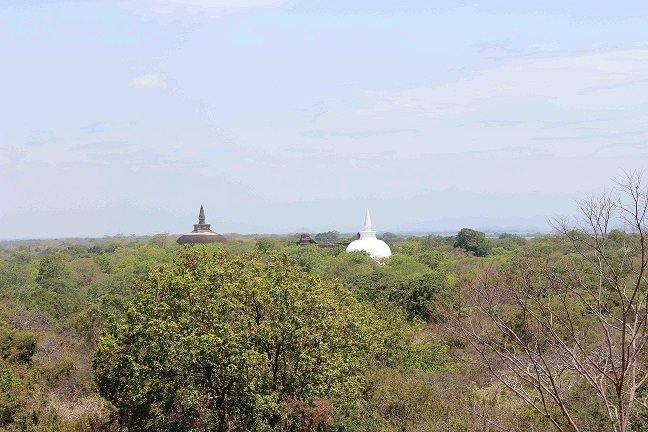Patrick Roberts Made National Geographic ‘Explorer’
Dr. Patrick Roberts of the Department of Archaeology, Max Planck Institute for the Science of Human History has received a National Geographic Explorer grant to further his work investigating the formation and collapse of urban societies in tropical Sri Lanka. The grant will support fieldwork in the summer of 2021 to obtain new lake and sediment records to reconstruct past environmental and climate change in association with the rise and fall of high-profile UNESCO urban sites, Polonnaruwa and Anuradhapura.
Climate change is one of the greatest threats to urban populations today. It has been argued that this was also the case in the past, with ancient urban societies being both stimulated, and threatened, by climatic variability. Sri Lanka is key for investigating this question because the first urban settlements in southern South Asia that were part of proto-globalized Indian Ocean trade connections spanning Asia, the Middle East, and Africa, formed in the seasonally arid, northern part of this island, between 2,500 and 700 years ago. The National Geographic Explorer grant will fund a project led by researchers from the Department of Archaeology in collaboration with the Max Planck Institute for Biogeochemistry, University of Jayawardenepura and GFZ Potsdam testing the impact of shifts in the Indian Ocean Monsoon on past human populations in this part of the world.
Urbanism and climate change in South Asia

A) Part of the ancient hydraulic system of Anuradhapura.
B) Parakrama Samudra tank at Polonnaruwa.
Researchers have argued that climate change and environmental variability stimulate both the formation and decline of ancient urbanism around the world. This is particularly so in the tropics, where urbanism has been considered particularly vulnerable to seasonal fluctuations in rainfall availability.
“Sri Lanka is globally significant for investigations of early urbanism in South Asia. Between 2,500 and 700 years ago, the UNESCO world heritage sites of Anuradhapura, and later Polonnaruwa, emerged as key nodes in vast trade networks spanning the majority of the Old World,” says Roberts. However, by the time British colonial officers arrived in the 19th century, these sites were all but abandoned.
The central position of Sri Lanka within the Indian Ocean makes it incredibly sensitive to changes in the Indian Ocean Monsoon system (IOM) that dictates the amount of precipitation and types of vegetation in different parts of the island. Today, fluctuations in this climate system are leading to deadly droughts and mudslides in Sri Lanka, and similar shifts are argued to have occurred in prehistory. Yet most arguments for the fall of prehistoric urbanism in northern Sri Lanka focus on the potential for military invasion and political collapse.
Environmental ‘exploration’
Complicating the study of urbanism and ecology in prehistory is the fact that there are very few records from Sri Lanka with which archaeologists can reconstruct past climate change. Where they do exist, they are either poorly dated or located very far away from the ancient urban centers of interest.
“The use of ‘off-site’ records, such as marine cores or very distant lake records, is a problem, as environmental changes identified may not be of direct relevance to people living in different places,” says Roberts.
This new National Geographic funded project seeks to produce well-dated, highly resolved records of precipitation and vegetation changes from human-relevant sediments in Sri Lanka. This includes nearby lakes in similar environmental situations, as well as human-built water systems. These will produce records which will finally enable archaeologists to assess whether monsoon changes in the past played a major, more cumulative, or more limited role in changes in the urban environments of the earliest cities in this part of the world.
Contributions to the present

Ancient Buddhist buildings, which can be seen above the treetops of the tropical forest near Polonnaruwa on Sri Lanka.
One of the major goals of this project is local capacity building and the education of different interest groups in how archaeological and environmental research can actively contribute to present perspectives on human-environment interactions in South Asia.
“Our plans include supporting the visits of grade school, undergraduate and Masters students, as well as local farmers and government officials, to the sites where we will present the results of our project, its interpretations, and what it means for the relationship between monsoonal changes and human adaptations in both the past and present of Sri Lanka,” says Roberts.
“It is crucial that this ‘exploration’ is done as part of a close local and international team that produces resources that will fuel interest in heritage, climate change policy, and urban strategies in Sri Lanka in the 21st century,” Roberts concludes.
The project will take place over the next 3 years and will also involve the close participation of photographers, filmmakers, and artists to document the research and its results in a more publicly accessible forum.
Links to the Explorer Grant application system, as well as to the research project page, can be found here:

